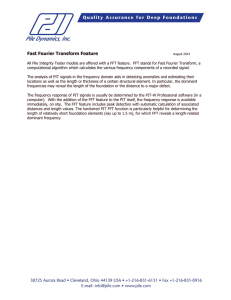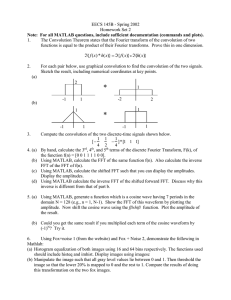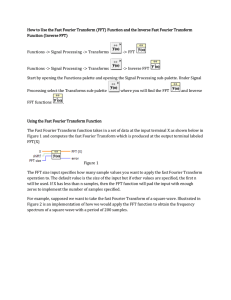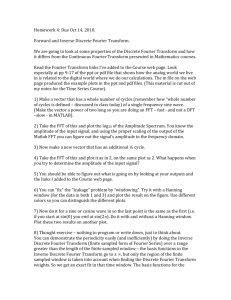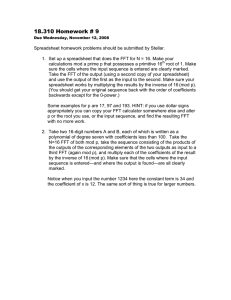THE FAST FOURIER TRANSFORM IN FINANCE BY: BARRETT WILLIAMS
advertisement
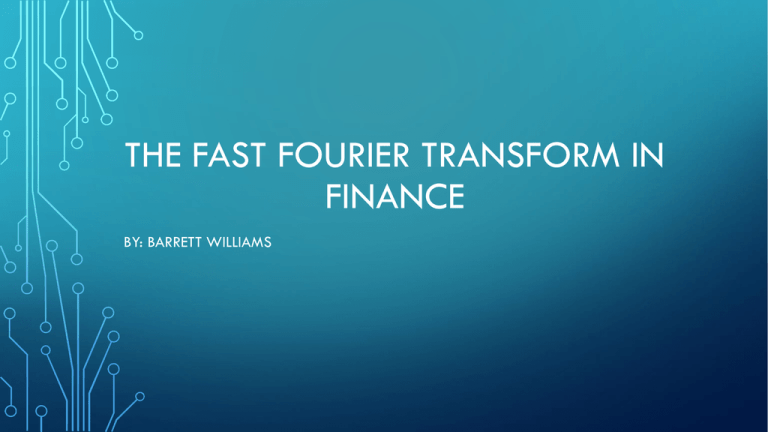
THE FAST FOURIER TRANSFORM IN FINANCE BY: BARRETT WILLIAMS KEY POINTS • What is a Fast Fourier Transform? • How are they used in finance? • My model and its outcomes • Improvements • Summary THE FAST FOURIER TRANSFORM • FFT: is an algorithm that computes the Discrete Fourier Transform of a sequence or its inverse, often times both are preformed. • Fourier Analysis finds a signal from the domain of the data, usually time or space, and transforms it into a representation of frequency. • The algorithm is used to predict future values in a multitude of different fields from environmental data to financial data. • 𝑁 −1 2 𝑛=0 −2𝜋 2𝑛 𝑖𝑘 𝑁 𝑎2𝑛 𝑒 + 𝑁 −1 2 𝑛=0 −2𝜋 2𝑛+1 𝑖𝑘 𝑁 𝑎2𝑛+1 𝑒 FFT IN FINANCE • They are mostly used to compute future predictions of the prices of financial derivatives. • Can be used for plain vanilla equities, but not normally implemented due to the fact that derivatives are more mathematically backed. Meaning that there are more parameters to aid in forecasting. • This type of valuation is mostly used by quantitative hedge funds that complex algorithmic trading strategies. employ FFT IN FINANCE • The following slides will be how the FFT is used to price an option call • 𝜔𝑘 = 2𝜋 −1 𝑁 𝑁 𝑒 𝑗=1 𝑗−1 𝑘−1 𝑋 𝑗 for k=1,…,N • N is typically a power of 2. The algorithm reduces it from 𝑁 2 to 𝑁𝑙𝑛2 (𝑁). The approximation of the call price 𝐶𝑇 𝑘 ≈ exp −𝛼𝑘 𝜋 𝑁 −𝑖𝑣𝑗 𝑘 𝑒 Ψ𝑇 𝑗=1 𝑣𝑗 𝜂 • The upper limit for integration is now 𝑎 = 𝑁𝜂. We are mostly focusing on near-the-money calls with this integration. • The FFT returns N values of k and we will then employ normal spacing of size λ, this gives us k values of: • 𝑘𝑢 = −𝑏 + λ(𝑢 − 1) for u=1,…,N FTT IN FINANCE • This returns log strike levels from –b to b, where 𝑏 = 12 𝑁λ • Incorporate Simpson's rule of weighting into the summation and the restriction λη = 2𝜋 , 𝑁 the call price can be rewritten as: 𝑢 • 𝐶𝑇 𝑘𝑢 ≈ exp −𝛼𝑘 𝜋 • 𝑁 −𝑖𝑣𝑗 𝑘 𝑒 Ψ𝑇 𝑗=1 𝑣𝑗 η 3 3 + −1 𝑗 − 𝛿𝑗−1 Where 𝛿_𝑛 is the Kronecker delta function that is unity for n=0 and zero otherwise. MODEL AND ITS OUTCOMES • Used a non-linear leastsquares to fit this quadratic equation. • Linear was not strong enough and a cubic fit went off to infinity because it tried to map the peaks to close and couldn’t. MODEL AND ITS OUTCOMES MODEL AND ITS OUTCOMES • I obtained the theoretical (predicted) values (red) by taking the IFFT of the curve I got from the first 162 days. I then used this to interpolate the next 90 days of data and plotted it against the actual 90 days (blue). • I obtained a 55% correlation, but my percent error was much than expected for only having a 55% correlation. I had a 15% error of average of the 90 interpolated data points. IMPROVEMENTS • The model works much better for stocks that are not as volatile, but I really wanted to test it. • I could implement spectral interpolation. This was one of the more popular ways to increase the resolution of FFT models • When looking at a peak in the frequency spectrum of a signal, the relationship between the bin of highest magnitude with those surrounding it can provide valuable information. • If, there is a relationship between consecutive FFT bin magnitudes, it can be used to approximate the exact frequency of the input sine, even if it is not equal to one of the bin frequencies. SUMMARY • FFT models have become very prominent in application do to there powerful and accurate prediction ability. • They are not going away in finance anytime soon.
